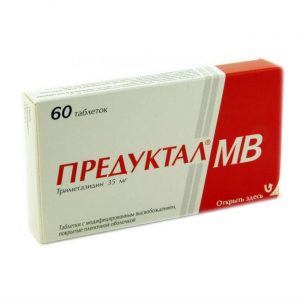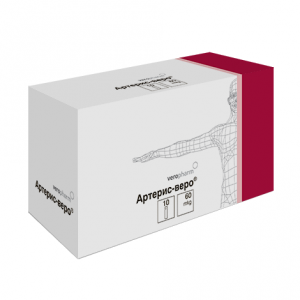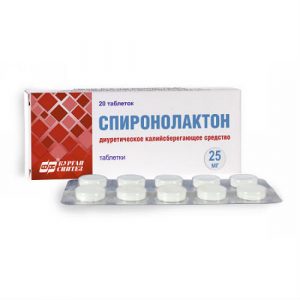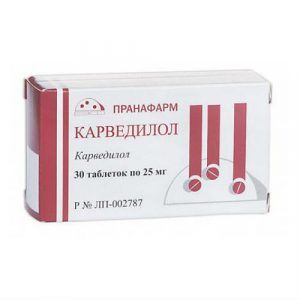Description
Latin name
NITROSORBIDE
Pharmacological action
Peripheral vasodilator with a primary effect on venous vessels. Antianginal agent. The mechanism of action is associated with the release of the active substance of nitric oxide in the smooth muscles of the vessels. Nitric oxide causes activation of guanylate cyclase and increases the level of cGMP, which ultimately leads to relaxation of smooth muscles. Under the influence of isosorbide dinitrate, arterioles and precapillary sphincters relax to a lesser extent than large arteries and veins. This is partially due to reflex reactions, as well as a less intensive formation of nitric oxide from the molecules of the active substance in the walls of arterioles.
The action of isosorbide dinitrate is mainly associated with a decrease in myocardial oxygen demand due to a decrease in preload (expansion of peripheral veins and a decrease in blood flow to the right atrium) and afterload (decrease in OPS), as well as with direct coronary expansion. Promotes redistribution of coronary blood flow in an area with reduced blood supply.
Increases exercise tolerance in patients with coronary artery disease, angina pectoris. With heart failure, it helps unload the myocardium by reducing preload. Reduces pressure in the pulmonary circulation.
Indications
For oral administration, sublingual, buccal: relief and prevention of angina attacks, rehabilitation treatment after myocardial infarction. Chronic heart failure (as part of combination therapy), some forms of pulmonary hypertension, pulmonary heart (as part of combination therapy).
For injection into the oral cavity: stopping and preventing angina attacks as an ambulance for acute myocardial infarction and acute left ventricular failure at the prehospital stage. Prevention and treatment of coronary artery spasm using a cardiac catheter.
For iv administration: acute myocardial infarction, incl. complicated by acute left ventricular failure unstable angina pulmonary edema.
For cutaneous use: prevention of angina attacks.
Contraindications
Severe arterial hypotension (systolic blood pressure less than 100 mm Hg, diastolic blood pressure less than 60 mm Hg), collapse, shock, acute myocardial infarction with severe arterial hypotension, cardiac hypertrophic obstructive heart disease, cardiomyopathy , toxic pulmonary edema, conditions accompanied by an increase in intracranial pressure (including hemorrhagic stroke, traumatic brain injury), angle-closure glaucoma, concomitant use of sildenafil (PDE inhibitor), increased ennaya sensitive to nitrates.
Use during pregnancy and lactation
Use of isosorbide dinitrate during pregnancy and lactation (breastfeeding) is only possible if the intended benefit to the mother outweighs the potential risk to the fetus or baby.
Special instructions
Use with caution in patients with cerebrovascular accidents, with aortic and / or mitral stenosis in patients prone to orthostatic hypotension in elderly patientsin. During the treatment period, especially in the case of a gradual increase in the dose, control of blood pressure and heart rate is necessary.
Do not allow alcohol during treatment.
Influence on the ability to drive vehicles and control mechanisms
During the treatment period, it is not recommended to drive vehicles and engage in other potentially dangerous activities, as with regular use of isosorbide dinitrate reduces the ability to concentrate and the speed of psychomotor reactions.
Composition
Active in-va: isosorbide dinitrate 10 mg
Auxiliary v-va: sugar, potato starch, calcium stearate
Dosing and Administration
When administered orally, a single dose is 10-120 mg, the frequency of administration is 1-5 times / day, depending on the indications and the dosage form used.
With sublingual or buccal administration, a single dose is 5-10 mg, the frequency of administration depends on the indications and patient response to treatment.
When injected into the oral cavity, 1-3 doses are used with an interval of about 30 seconds against the background of breath holding. In acute myocardial infarction and acute heart failure, the initial dose is 1-3 injections. If after 5 min there is no improvement, the injection can be repeated under the condition of constant monitoring of blood pressure and heart rate. For the prevention of coronary spasm in case of catheterization, 1-2 doses should be used immediately before the procedure.
For iv administration, the dosage regimen depends on the clinical situation and the dosage form used.
For cutaneous use, the initial dose is 1 g at night, before bedtime, and if necessary in the morning.
The duration of treatment is determined in each case individually.
Side effects of
From the cardiovascular system: dizziness, headache, tachycardia, transient facial hyperemia, sensation of heat, hypotension in some cases – increased angina attacks (paradoxical reaction).
From the digestive system: nausea, vomiting, sensation of a slight burning sensation of the tongue, dry mouth.
From the side of the central nervous system and peripheral nervous system: drowsiness, blurred vision rarely – cerebral ischemia and collapse.
Allergic reactions: skin rash.
Drug Interactions
When used simultaneously with adsorbents, binders and coatings, the absorption of isosorbide dinitrate decreases.
With the simultaneous use of antihypertensive drugs, peripheral vasodilators, calcium channel blockers, beta-blockers, antipsychotics (antipsychotics), tricyclic antidepressants, PDE inhibitors, ethanol may increase the hypotensive effect.
With simultaneous use with anticholinergics, impaired memory and attention in elderly patients.
With simultaneous use with sympathomimetic agents, the antianginal effect of isosorbide dinitrate may be reduced.
With simultaneous use with dihydroergotamine, an increase in concentration and an increase in the action of dihydroergotamine are possible.
With simultaneous use with norepinephrine, the therapeutic effect of norepinephrine decreases.
With simultaneous use with sildenafil, there is a risk of developing severe arterial hypotension and myocardial infarction.
Terms and conditions otpuska IZ pharmacy prescription
dosage form
tablets
Indications
Ostr y myocardial infarction, Angina




